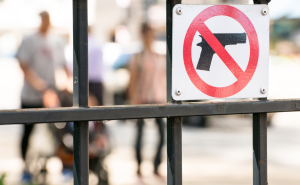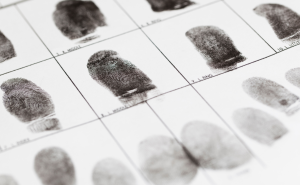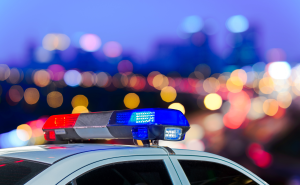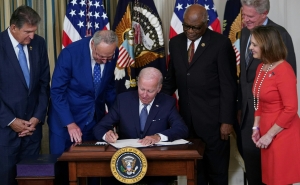Locked and UN-loaded: The Importance of Safe and Secure Firearm Storage
Safely and securely storing firearms can reduce gun injuries and deaths, and is a practice supported by researchers, health care professionals, and gun owners alike.

Responsible gun ownership is not only about how, where, and when a person uses their firearm; it’s also about how they store it when not in use. However, only about half of gun owners practice safe and secure firearm storage.
Cassandra Crifasi, PhD ’14, MPH, co-director of the Johns Hopkins Center for Gun Violence Solutions and a gun owner herself, explains best practices for safely and securely storing firearms and how doing so reduces injuries, homicides, and suicides, and mass shootings.
When we say safe and secure gun storage, what exactly does that mean?
Safe and secure are two complementary components: Safe means unloaded, and secure means locked up. Putting these two together, the most quintessential safe and secure storage is a gun being unloaded, locked in a gun safe or lockbox, and the ammunition is stored separately.
Each step closer to the gun being ready to fire introduces opportunities for unintentional injury. So ideally, ammunition is stored in a different lockbox, but for some people who own guns for home- or self-defense, the idea of storing ammunition separately is not appealing. If that’s the case, guns should be locked in a quick-access safe, preferably unloaded. The ammunition can be in the magazine in the same lockbox, but not loaded. If it does have to be loaded, it shouldn’t have a round chambered.
What are some other ways to store a firearm?
Firearm storage is a spectrum. At one end is the least safe and secure: having a loaded, unsecured handgun somewhere in the house. At the other end is the preferred method: unloaded and locked up.
Between those are various ways people can practice some level of gun storage, including trigger locks, which prevent the trigger from being pulled, and metal cable locks, which go through the magazine well or ejection port and lock with a key. Cable locks typically prevent guns from being loaded while locked.
These methods generally don't meet best practices for safe and secure storage, and they can even create a false sense of security. Trigger locks still allow a gun to be loaded, and applying one to an already loaded gun has caused people to unintentionally discharge the firearm. A cable lock can be cut off with everyday tools. But at the end of the day, we have to meet people where they are; something is better than nothing when it comes to firearm storage.
What if someone doesn’t have a place in the house to safely and securely store a firearm?
We need to challenge the notion that it isn’t possible or convenient to safely and securely store a firearm in a home. There are lots of high-quality safes that are the size of an encyclopedia, and it’s easy to install a safe that’s bolted to your bed frame, the floor, or the wall.
That said, there may be times when people want to store guns outside of the home, and there are locations across states that offer temporary offsite gun storage. Our Center has worked with partners in Maryland to create a map of all of these places—including gun shops, armories, gun ranges, and law enforcement agencies—based on a similar project in Colorado. Some places allow you to rent a locker, others will take the gun into their inventory, but it’s entirely voluntary, no questions asked, and the owner can retrieve it at any time.
What are some common mistakes people make when it comes to gun storage?
Mistakes are often rooted in misconceptions. For example, that safe and secure storage is costly, burdensome, inconvenient, or not conducive to home defense. In fact, a high-quality quick-access safe can cost as little as $50, and they’re designed to allow the contents to be accessible within seconds.
Another common mistake is assuming that it’s sufficient to put a gun up high, out of reach of small children, or believing that kids don’t know where a gun is stored. In fact, the majority of children know exactly where a gun is stored and how to access it within minutes.
The third mistake is not taking storage as seriously out in public as one might at home. Let's say I have a concealed carry license. There are still places where I can't legally carry a gun and have to leave it in my car to enter. If that gun isn’t stored in a car-compatible safe, there’s an increased likelihood it could be stolen and used to harm someone. Guns stolen from vehicles and homes are a major source for the underground gun market, and they contribute to interpersonal violence in a lot of minoritized communities.
How do we know that safe and secure gun storage is effective?
One of the core tenets of injury prevention is that to prevent injury, we separate—in time and space—the harm from that which is to be protected. We know that the use of a firearm to harm oneself or others can sometimes be impulsive. If my gun is stored loaded in a nightstand drawer, there's very little to slow me down and allow me to question whether I should use it in a given circumstance. But if my gun is in a gun safe, I have to open the safe. And if my gun is stored unloaded, as recommended, I have to separately access ammunition. Even just a few seconds’ delay is time I can reconsider or someone can intervene.
We also see that in homes where youth are dying from firearm suicide, those guns are far more likely to be stored loaded and unlocked. And in cases of youth and adolescents committing school shootings, the vast majority of them have gotten guns from their home or the home of a family member. When we have safe and secure gun storage that is required by law through child access prevention laws, we see lower rates of youth and adolescent suicide. In all of these cases, the data show that harm is reduced when we require that guns be stored in a way that minimizes unsupervised or unauthorized access.
What factors influence whether someone practices safe and secure storage?
Individuals whose storage behaviors were influenced by participating in firearm safety training are more likely to store their guns safely. Gun owners with young kids in the home have higher rates—though still too low—of safe and secure storage than those without young kids. People who have concerns around self-defense, on the other hand, are less likely to store all their guns safely and securely.
Overall, not nearly enough gun owners practice safe and secure storage. Through our survey work, we’ve found that only about half of all gun owners practice safe and secure storage for all of their guns. Other research has found that around 4–5 million kids live in homes with at least one gun that is not stored safely and securely. That’s 4–5 million kids who could very quickly gain access to a loaded and unlocked firearm.
How do we encourage more people to store their guns safely and securely?
It all comes back to messaging. We need to challenge the narrative that safe and secure gun storage and home defense are inconsistent with each other. It just isn’t true.
We also need to push back against a common talking point by the gun industry and gun manufacturers that you don't want to be a victim because you didn't have a gun at the ready. The reality is that if you don't have a firearm physically on your person, having it stored in a gun safe or a lockbox is a much better option: Not only is the likelihood of needing to use a firearm in self-defense exceptionally low, but it’s also far more likely that a gun in the home will be used to harm a household member.
Bringing a gun into the home can increase the risk of homicide and suicide by as much as threefold. Storing guns safely and securely can minimize that risk.
Aliza Rosen is a digital content strategist in the Office of External Affairs at the Johns Hopkins Bloomberg School of Public Health.





